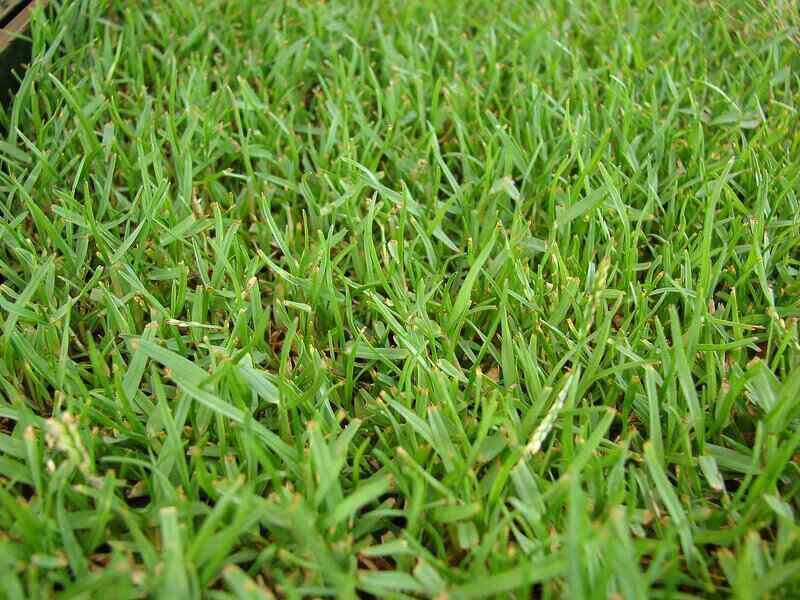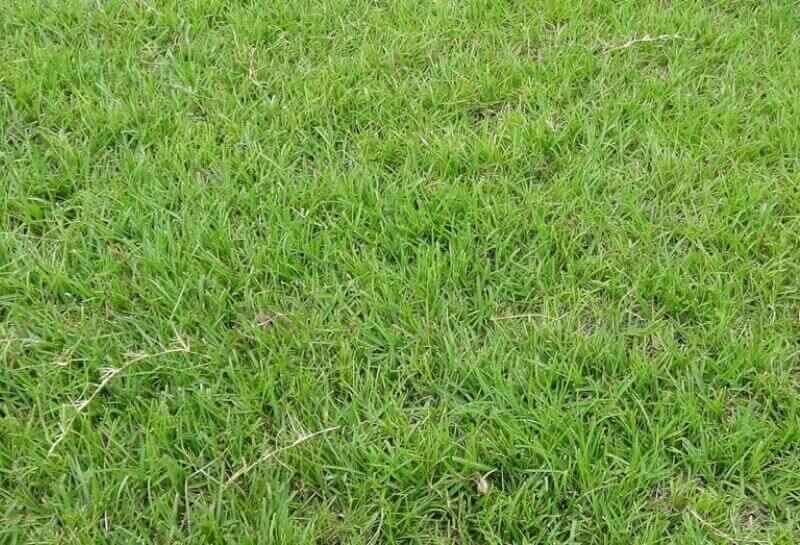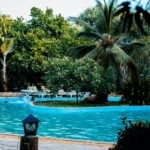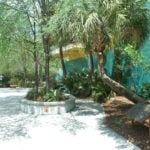
Sarasota’s sunshine is legendary, as are its hot days and sandy beaches. But what about your yard? If your lawn doesn’t quite look like you want, try finding the right warm-season grass for it. Read here for the five best grass types for Sarasota.
These five best grasses are:
Later, we’ll explain how to choose the best grass type for your Sarasota lawn. Let’s dive in:
St. Augustinegrass

Photo Credit: Yercaud-elango / Wikimedia Commons / CC BY-SA 4.0
In Florida, St. Augustinegrass is the most commonly used turfgrass. Highly tolerant of salt, it can also tough out short-term flooding, making it a “natural seashore plant.” To prevent excessive weed, insect, and disease issues in St. Augustinegrass, be careful not to overwater, over fertilize, or cut too low.
St. Augustinegrass remains popular in Sarasota because of its thick, carpeted turf and shade tolerance. Of all the warm-season grasses, this Florida favorite happens to be the least cold tolerant. It becomes brown and dormant in winter but grows vigorously during the heat of the spring, summer, and early fall.
Classification: Warm-season grass
Spreads by: Stolons
Shade tolerance: Moderate. It is the most shade-tolerant warm-season grass.
Drought tolerance: Moderate to high
Foot traffic tolerance: Low
Maintenance needs: High. Needs frequent mowing due to fast growth rate; develops thatch easily; needs regular fertilization
Mowing height: Set the mowing height between 3.5 and 4 inches.
Potential for disease: Moderate to high
Soil pH: 6-7.5
Soil type: Tolerates many soil types; prefers moderately fertile and moist, not waterlogged, soils; doesn’t tolerate soil compaction
Varieties: Palmetto, Floratam, Raleigh, Mercedes, Bitterblue, Jade
Other notes: Watch out when applying herbicides because this grass is sensitive to some; be sure to carefully read labels.
Grass Plug Options:
– Seed Ranch St Augustine Seville Grass Plugs (2 Trays)
– Seed Ranch St Augustine Floratam Grass Plugs (2 Trays)
Zoysiagrass

Photo Credit: Forest & Kim Starr / Wikimedia Commons / CC BY 3.0 US
Zoysiagrass feels soft underfoot, so it is good for high-traffic yards. It lives in sands or clays and tolerates salt, and it’s widely grown along Florida’s sandy seashores. Named after Karl von Zois, a Slovenian botanist, Zoysiagrass does not tolerate poorly drained soils and is moderately drought tolerant, though it will turn brown quickly to survive.
Zoysiagrass turns the color of straw after the first hard frost but is among the first warm-season grasses to green up in April. Native to Southeast Asia, it requires frequent mowing to produce the finest lawn, but you can mow less frequently during the summer if you’re willing to compromise some on quality.
Classification: Warm-season grass
Spreads by: Stolons and rhizomes
Shade tolerance: Moderate. Needs 4-5 hours of full sun.
Drought tolerance: Moderate
Foot traffic tolerance: High, but recovers slowly from damage
Maintenance needs: Low nitrogen fertilization requirements, although it’s prone to thatch build-up. Weekly mowing during the summer.
Mowing height: Set mowing height between 1 and 2 inches.
Potential for disease: Good disease tolerance overall
Soil pH: 6-6.5
Soil type: Well-draining, some cultivars more tolerant of a wide range of soils than others
Varieties: Cavalier, Zorro, Emerald, El Toro, Zenith, Zeon
Other notes: Zoysiagrass generally requires no mowing between October and April.
Grass Plug and Seed Options:
– Zoysia Plugs (50 Large Grass Plugs)
– Zoysia Plugs (50 Full & Lush Grass Plugs)
– Zoysia Plugs (100 Plugs)
– Zenith Zoysia Grass Seeds (1/8 lb. of seeds)
Bahiagrass

Photo Credit: Forest and Kim Starr / Flickr / CC BY 2.0
If you have a mostly sunny yard, bahiagrass is the grass for you; it prefers full sun but tolerates limited shade. Native to South America and introduced into the United States in 1913, it grows well in sandy soil and harsh conditions; in fact, its deep root system allows it to survive droughts. It’s also good for yards with erosion problems.
Bahiagrass does not produce a dense, carpet-like lawn. If you want to encourage growth, though, you can stop mowing for a while or overseed to help thicken the turf. Although this grass type won’t be as dense as Zoysiagrass, it requires less maintenance than Bermudagrass or St. Augustinegrass.
Classification: Warm-season grass
Spreads by: Stolons
Shade tolerance: Low, but more shade tolerant than Bermudagrass.
Drought tolerance: Moderate. Bahiagrass goes into dormancy, turning brown and stopping growing in long droughts.
Foot traffic tolerance: Low
Maintenance needs: Low fertility requirements. Expect frequent mowing (every one to two weeks) to remove seed heads.
Mowing height: Ideal grass height is 3 to 4 inches.
Potential for disease: Good resistance to disease and insect infestations
Soil pH: 5.5-6.5
Soil type: Performs well in sandy loam soils, but tolerates a wide range of soils, including soils with low fertility.
Varieties: Pensacola, Argentine, TifQuik, Tifton 9, UF Riata
Other notes: Bahiagrass can be established via seed or sod.
Grass Seed Options
Pensacola Bahiagrass:
– SeedRanch Pensacola Bahiagrass Seed (10 lb. bag)
– Hancock Seed Co. Pensacola Bahiagrass Seed (5 lb. bag)
Argentine Bahiagrass:
– Scotts Turf Builder Argentine Bahiagrass (10 lb. bag)
– Hancock Seed Co. Argentine Bahiagrass Seed Mix (25 lb. bag)
Bermudagrass

Photo Credit: Matt Levin / Flickr / CC BY-SA 2.0
A great choice if you have young children or pets, Bermudagrass is often used on golf courses and sports fields. Common throughout the South, this grass resists damage because it grows so fast and has deep roots. In addition, it has excellent tolerance to heat, drought, and humidity.
However, “The aggressive properties that make it a desirable turfgrass also make it a major weed.” Bermudagrass can spread into flower beds and onto walkways, but you can take steps to control its growth. Lack of water causes this grass to go dormant and turn brown, but it can survive drought better than other warm-season grasses.
Classification: Warm-season grass
Spreads by: Stolons and rhizomes
Shade tolerance: Low; thrives in full sun
Drought tolerance: High
Foot traffic tolerance: High
Maintenance needs: Needs frequent mowing due to fast growth rate; develops thatch easily; needs regular fertilization
Mowing height: Set the mowing height between 0.5 and 1.5 inches for hybrid Bermudagrass cultivars. Mow common Bermudagrass down to 1.5 to 2.5 inches.
Potential for disease: Good resistance to disease, although diseases are common; low resistance to insects
Soil pH: 6-6.5
Soil type: Tolerates most soil types. Likes well-drained soil.
Varieties: Celebration, Sunturf, Tiflawn
Other notes: Bermudagrass’ salt tolerance is high, making it a smart choice for coastal areas. It also produces a lot of pollen if it goes to seed, so allergy sufferers beware.
Grass Seed Options:
– Scotts Turf Builder Bermudagrass (10-lb. bag)
– Hancock Seed Co. Bermudagrass (50-lb. bag)
Centipedegrass

Photo credit: Michael Rivera / Wikimedia Commons / CC BY-SA 4.0
Often referred to as “lazy man’s grass” due to its low maintenance requirements, centipedegrass doesn’t need you to mow it as much as Bermudagrass or St. Augustinegrass do. However, thatch can be problematic, so try dethatching when it reaches more than 1/2-inch thick.
First introduced into the United States from South China in 1916, this grass can be prone to a disease called centipede decline, in which a previously well lawn doesn’t green up. Causes include too-short mowing, overfertilization, alkaline soil, and an unhealthy root system.
Classification: Warm-season grass
Spreads by: Stolons
Shade tolerance: Moderate. Needs at least 6 hours of full sun.
Drought tolerance: Moderate. Water management is important during the summer. Prone to excessive thatch.
Foot traffic tolerance: Low
Maintenance needs: Low. Fertilize once a year.
Mowing height: Set the mowing height between 1 and 2 inches.
Potential for disease: Good resistance to diseases and insects
Soil pH: 5-6
Soil type: Acidic, sandy, infertile, at least moderately good drainage (very dense, clay soils produce poor results)
Varieties: Several varieties work well in Northern and Central Florida, but ‘Hammock’ centipedegrass works best for South Florida.
Other notes: Not a grass for high traffic lawns. Has an “apple green” color and poor salt tolerance.
Grass Seed Options:
– Gulf Kist Coated Centipedegrass Seeds (1 lb.)
– Scotts EZ Seed Patch and Repair Centipedegrass (3.75 lbs.)
– TifBlair Centipedegrass (5-lb. bag)
How to Choose the Best Grass Type for Your Sarasota Lawn
Shade Tolerance
Does your yard have a lot of large trees? Then you’ll want to plant a grass with a higher shade tolerance. If you don’t have large trees, look to a grass with a low shade tolerance but keep in mind that your smaller trees will grow.
Moderate shade tolerance: St. Augustinegrass, Zoysiagrass, centipedegrass
Low shade tolerance: Bahiagrass, Bermudagrass
Heavy Foot Traffic
If your kids and pets like to play outside, you’ll need a grass that stands up to hard wear and tear. Some grasses resist such use, and some are more sensitive and take more time to recover.
High foot traffic: Zoysiagrass, Bermudagrass
Low foot traffic: St. Augustinegrass, bahiagrass, centipedegrass
Salt Tolerance
Being so close to the ocean, Sarasotans must have a grass with a good salt tolerance. You’re good to go with three of these warm-weather grasses.
High salt tolerance: St. Augustinegrass, Bermudagrass, Zoysiagrass
Low salt tolerance: Centipedegrass, Bahiagrass
High vs. Low Maintenance
Do you like to get your exercise by spending time watering, fertilizing, mowing, and otherwise maintaining your grass? Then a high- or moderate-maintenance yard is for you. Or do you want to sit by the pool with your tall, iced beverage? Then pick a low-maintenance grass.
High-maintenance grasses: St. Augustinegrass, Bermudagrass
Moderate-maintenance grasses: Zoysiagrass
Low-maintenance grasses: Bahiagrass, centipedegrass (called lazy man’s grass)
Drought Tolerance
Sarasotans need a grass with a high or moderate drought tolerance because this area’s almost always really dry or in a drought.
High drought tolerance: Bermudagrass
High to moderate drought tolerance: St. Augustinegrass
Moderate drought tolerance: Zoysiagrass, bahiagrass, centipedegrass
When to Call in a Lawn Care Pro
Picking a grass type can be challenging, but if you still can’t decide, or you just want a professional to take care of your lawn so that you can enjoy all that Florida has to offer, call a local LawnStarter lawn care pro in Sarasota.
Additional sources:
Main Image Credit: Roger W / Flickr / CC BY-SA 2.0
LawnStarter participates in the Amazon Services LLC Associates Program, an affiliate advertising program. LawnStarter may earn revenue from products promoted in this article.





